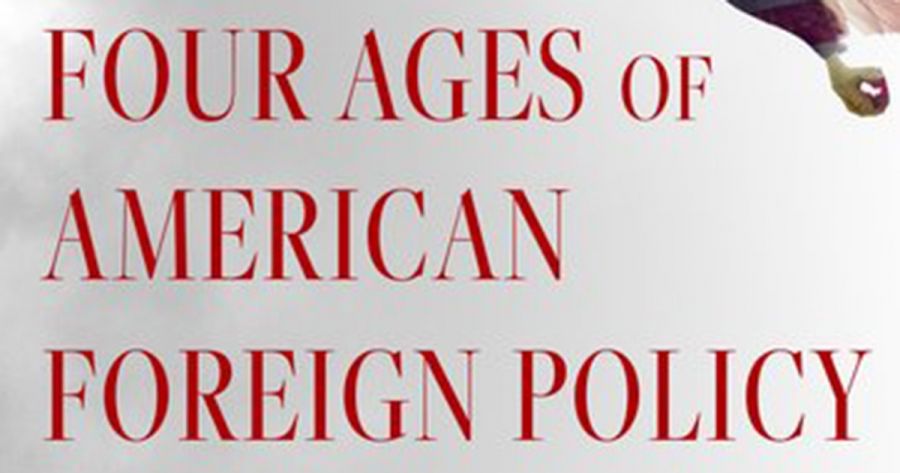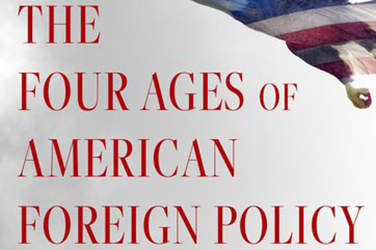
- Free Article: No
- Contents Category: Politics
- Review Article: Yes
- Article Title: The soaring eagle
- Article Subtitle: Revisiting the history of US foreign policy
- Online Only: No
- Custom Highlight Text:
Michael Mandelbaum’s book The Four Ages of American Foreign Policy is intended as another instalment, the author argues (quoting Pieter Geyl), in history’s ‘argument without end’. Historians of US foreign policy have long been engaged in their own particular argument – mostly, a competition over naming rights. In the most prestigious instalments – and Mandelbaum’s contribution is certainly one of those – the argument is not so much over the substance of history, but over its categorisation.
- Article Hero Image (920px wide):

- Article Hero Image Caption: An American shell casing factory c.1918 (akg images/Alamy)
- Featured Image (400px * 250px):

- Alt Tag (Featured Image): Emma Shortis reviews 'The Four Ages of American Foreign Policy: Weak power, great power, superpower, hyperpower' by Michael Mandelbaum
- Book 1 Title: The Four Ages of American Foreign Policy
- Book 1 Subtitle: Weak power, great power, superpower, hyperpower
- Book 1 Biblio: Oxford University Press, £26.99 hb, 512 pp
- Book 1 Cover Small (400 x 600):

- Book 1 Cover (800 x 1200):

In the significant and meticulously detailed history the book offers, Mandelbaum traces decision making and power dynamics across nearly three centuries of American power. That accessible, readable, and compelling detail jars, though, with the abstraction of Mandelbaum’s theorising. Early on in the book, for example, Mandelbaum sets out his case for analysing and explaining the rise of the United States from weak power to hyperpower. The United States achieved that status, he claims, ‘through the expansion of its power; of its wealth, which is the foundation of power’. In this passive construction, there is no mention of who built that wealth, or where it came from; no mention of the enslavement and dispossession on which that wealth, and thus power, rest. Mandelbaum describes the North American continent, multiple times, as ‘wilderness’ or ‘vast wilderness’, falling into long discredited descriptions of a place that, when white colonisers arrived from Europe, was no such thing.
The underlying argument, in so many histories of US foreign policy, is that while outcomes might occasionally be bad, intentions were always good. Too many of these histories offer a generosity of interpretation that should not be afforded to those with such immense power who have made such immense mistakes. In his detailed historical analysis of specific events, Mandelbaum is better at avoiding this trap than many of his colleagues and predecessors. He argues, correctly, that when the two grand approaches to foreign policy that have characterised US decision making – realism and idealism – have clashed, realism has usually won out. Nevertheless, the underlying argument is there, just below the surface. Given that the cover design consists of a classic, clichéd American image – a bald eagle, wings outstretched, with the stars and stripes superimposed over its feathers – that shouldn’t come as a surprise to readers.
Just as the soaring eagle suggests, like many of his colleagues, Mandelbaum’s central thesis is that the United States is different and special – it is always, in the end, exceptional. The nation’s foreign policy has been, from the start, ‘distinctly American’ in that it has had ‘ideological goals’, that it has used ‘economic instruments in pursuit of them and a democratic process for formulating and implementing decisions about it’. The democratic process is, Mandelbaum argues, ‘unusual’ in the world. The book, though, is focused entirely on the United States – there is no detailed explanation or comparative work to justify this rather tired analysis of America’s role in the world.
While it is entirely possible and even justifiable to make this argument, and to categorise the history of the United States in the world into these four periods, the theoretical basis for it all is uncomfortably teleological and deterministic.
As Mandelbaum sets out the justification for his analysis of American power, he explains international structures and the behaviour of states through the metaphor of the ‘jungle’. Mandelbaum describes an international arena as much like nature, red in tooth and claw – just as occurs in the jungle, states are locked into ‘fierce, deadly competition’. In one particularly off-putting passage, Mandelbaum notes that in the jungle (or is it when states deal with other powers?), ‘predatory mammals do fight others of the same species, for control of territory, access to females, and food’. The cavalier and – for this reader, at least – deeply offensive use of the phrase ‘access to females’ in a passage ostensibly describing the behaviour of powerful states and the human decision makers within them, points to a largely unexamined hyper-masculinist approach to understanding international relations.
Furthermore, this understanding and deployment of the ‘natural’ as a vehicle for explaining the relative power and behaviour of states is deeply unscientific. The simplistic jungle metaphor fails to engage with very different approaches to understanding the ‘natural’ world that see relationships as complex, reciprocal, or symbiotic. It also understands ‘nature’ and its component relationships as fixed and inevitable.
As we know all too well, that is far from the truth. ‘Nature’ is not fixed; systems can and do change rapidly. They are doing so now because of nation states’ behaviour, and one of those states and its foreign policies is more responsible for that change than most others. To take the metaphor further, the ‘predatory mammals’ Mandelbaum describes with such relish do not, generally speaking, consciously destroy the very environment upon which they depend. A less conventional approach to the history of international relations might have acknowledged that the jungle, and the states within it that apparently behave like animals, require a functioning biosphere to survive – even if they are hyperpowers.


Comments powered by CComment